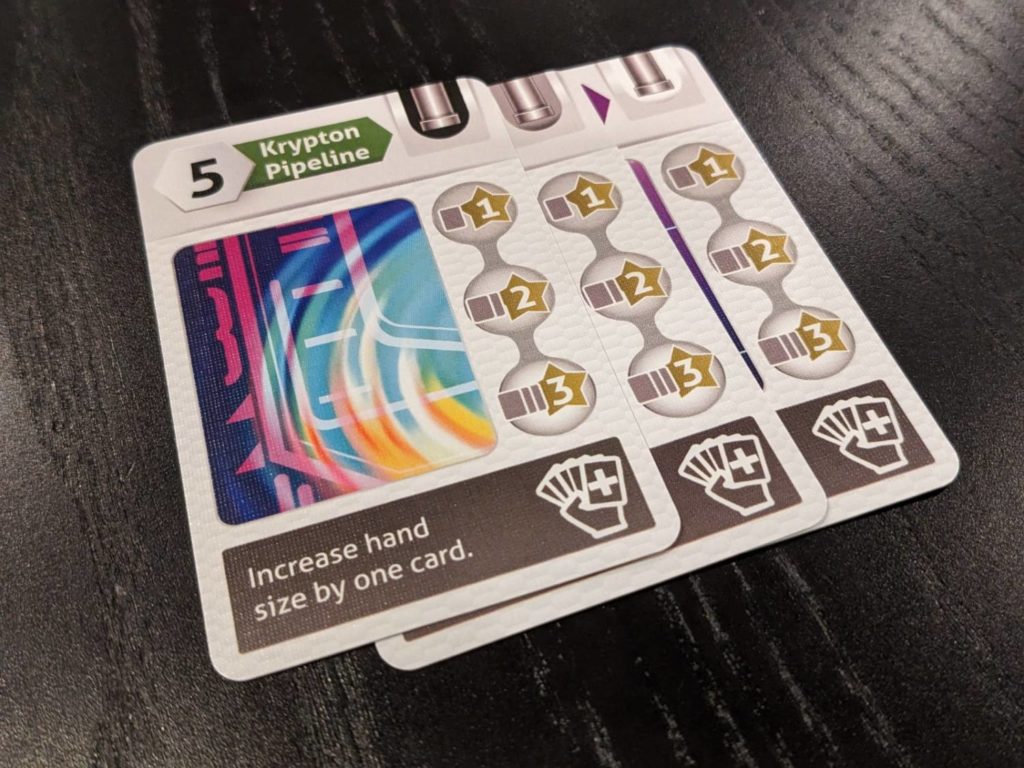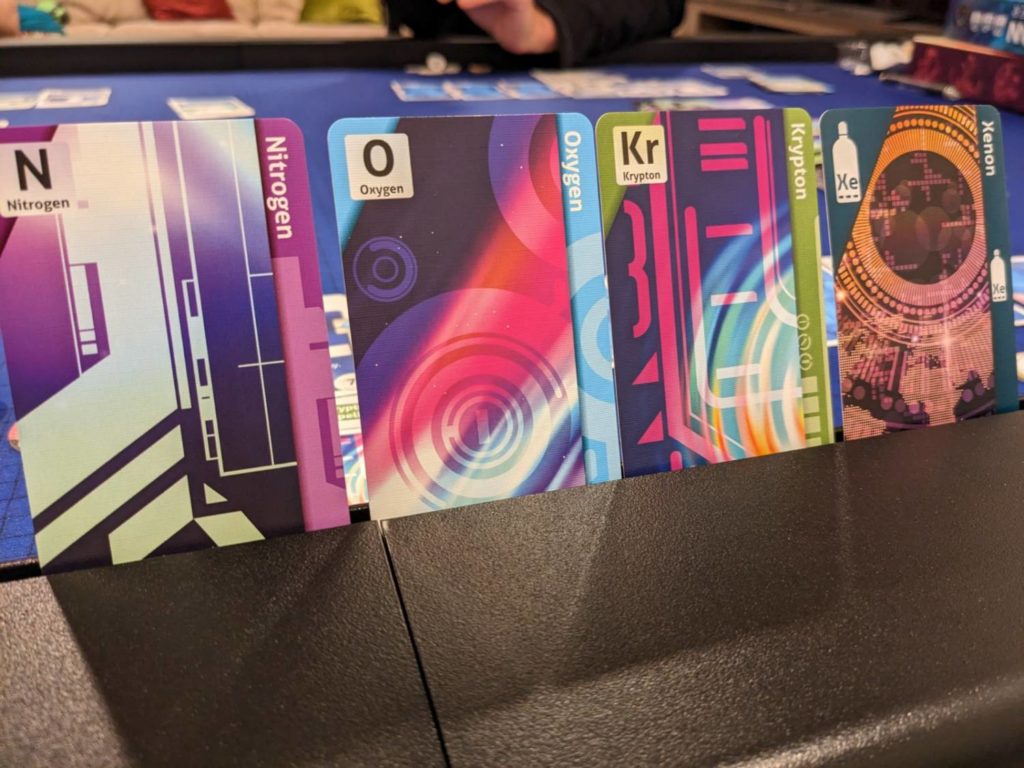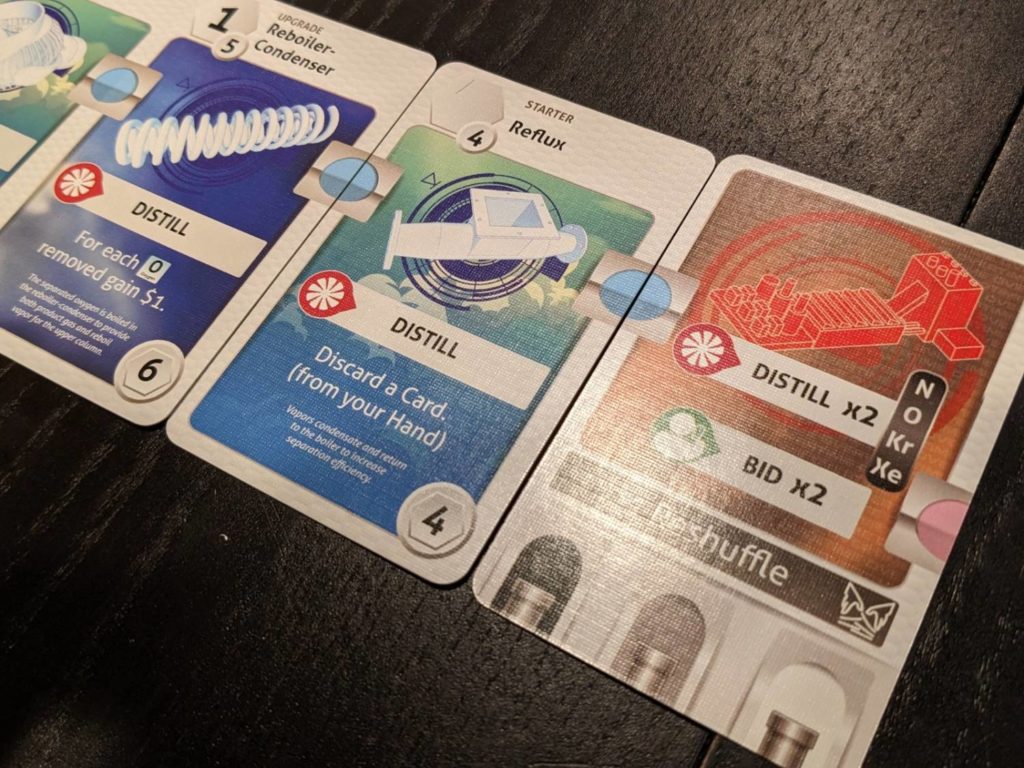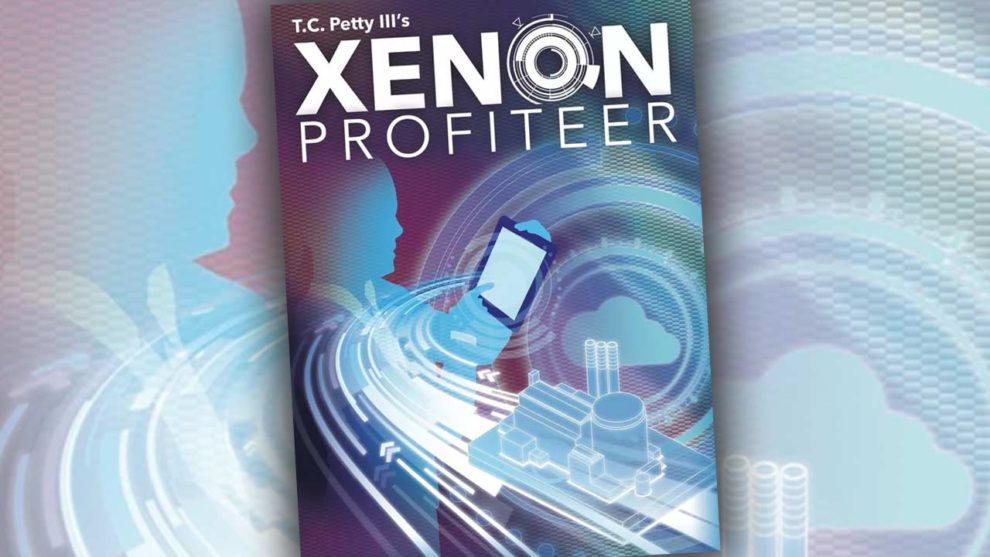Disclosure: Meeple Mountain received a free copy of this product in exchange for an honest, unbiased review. This review is not intended to be an endorsement.
Six or seven years ago, I had the chance to play Xenon Profiteer (2015, Eagle-Gryphon Games) at a bar with friends in Chicago. I can still see my friend’s face when he whipped the game out of his satchel and proceeded to sell the group on why we should play…and all I could think was
“Who the **** calls their game Xenon Profiteer? That’s got to be the worst name for a game in gaming history!”
Like, really, think about it! Think of all the games you have played. Can you come up with anything even resembling the idea that the goal of your game is to profit off the sale of freakin’ XENON?????
I dare you! I double dare you!
Anyway, my friend starts the teach, and my mind is buzzing with the idea that I’m about to play one of the worst games ever (if anything, the worst-named game ever). But something happens as he walks us through the steps of a turn.
Slowly, I latch on. Then we begin the game, and I’m kind of, well, excited to distill xenon to make some money on a government contract. I remember having fun, so I was thrilled Eagle-Gryphon Games agreed to share a review copy.
I needed to know: is Xenon Profiteer—designed by TC Petty III, the guy who gave us GI JOE Deck-Building Game and My Father’s Work—still interesting, now that I’ve played hundreds of other games and dozens of other deck/bag/pool builders?

It’s Krypton, Not Kryptonite
Xenon Profiteer pits 2-5 players in a race to the death, to see who can best distill xenon for a variety of anxious, bloodthirsty clients.
Well, not really. Xenon Profiteer positions 2-5 players as engineering entrepreneurs, vying to develop the best Air Separation Facility while building up a system (deck of cards) that can quickly produce xenon. Xenon is a rare gas that has been used for dozens of technological advances over the years; as an entrepreneur who recognizes the steep financial upside of xenon, you’ll race the competition to complete valuable contracts that contribute to the majority of each player’s end-game scoring.
Starting with a deck of ten cards in your system, your goal is to distill the gasses in your deck down to xenon as often as possible. The xenon that gets isolated in a player’s hand can then be taken out of the deck and attached to an active contract in that player’s tableau, known as their Center Console. (To say this game is for nerds, in a hobby already known for its nerdism, would be an understatement.)
Each normal turn plays out the same way. You’ll draw five or more cards from your deck—this number can rise if a player has added a pipeline to their Center Console, raising their draw limit—then lay out all of your cards on the table. They will be a mix of the game’s four main gasses: nitrogen, oxygen, krypton, and xenon, as well as any upgrade cards acquired during previous turns.
Your first requirement is to distill the gas that is highest on the list for distillation purposes, in the order listed above. All the cards that match will be tossed back to the supply. If this leaves only xenon, great news—that also comes out of your hand, and is then placed near your console to be attached to any contracts you are currently working on.
If this leaves any other gasses, those cards can be kept for your next turn, or discarded, or mixed then matched to make up your next hand.

The next step in a turn: adding a packet of air and $2 to your play area, or removing cards from the market. The packet of air is four cards: a nitrogen, an oxygen, a krypton, and a xenon, and each of these cards is added to your discard pile. Yes, this does grow your deck size, but only temporarily given the distilling process. If you don’t want or need to add an air packet, you could instead remove cards from the market of contract and upgrade cards using the Wipe action.
Finally, players can either bid on or buy a single card from the market. There are always four face-up contracts—each with a xenon card requirement, and a number of points that will score at the end of the game—and four upgrade cards available. Upgrades are one-time abilities when they are played from hand, but they are permanent, every-turn abilities when added to the Center Console.
Upgrades are fantastically layered. There’s a small price to buy them out of the market, and a large price to add them directly to the Console. There’s also a medium price that makes up the difference: you could pay the small price to add the card to your discard pile, then later pay the medium price to add it to your Console from hand later in the game. Options!!
Bidding on a card requires one of your five bidding tokens. Placing a bid token on a card discounts an upgrade by $1 on a future turn, or grants a player $1 when taking a contract (because all contracts are free buys). It also requires other players to compensate the ones who have a bid token on a card, so you’ll at least get a buck if someone else snipes your card before you can take it later.
When a player has completed five contracts, or installed five upgrades into their system, each player gets one final turn before scores are added up. (An exception: if the player who triggered the end would like, they can take a three-point bonus instead of taking a final turn.) Contracts make up the bulk of the final numbers, but there’s also a multiplier added for any pipelines that were purchases, upgrades installed, and leftover cash.

It’s a Deckbuilder–Therefore…
I am predisposed to like games such as Xenon Profiteer because they force players into buying new cards for their decks while efficiently shaving some of those cards out of the game to score the most points. And all these years later, I think Xenon Profiteer still works for me.
That’s because it just feels good to shave oxygen or krypton cards out of the deck to slim it down and get at that sweet, sweet xenon. The upgrade cards can make for slick turns. There’s “Overtime”—the chance every other turn to deviate from the standard turn by flipping your Center Console card and distilling not once, but twice, to push a lot more cards out of play. (This comes at a cost: you can’t buy any cards on an Overtime turn.)
So new players will be able to sort the main turn mechanisms quickly…and experienced players will have more of a sense of when they should pivot to Overtime or take on certain contracts. The whole thing is a roughly 30-minute game with 2-3 experienced players, and about an hour with 3-4 new players. That feels right, and turns are quick so downtime is fairly light.
Xenon Profiteer sounds like a science nerd’s dream, but the reality is that the science-y parts don’t really come into play. That’s because the one missed opportunity with the artwork in Xenon Profiteer is that the cards are pretty bland. They do the job, but cards that say things like XXXX, they should have a picture that sort of looks like that. But the cards take on a strange silhouette approach for every subject.
Also, I still don’t know why the contracts come in three different suits, when the suits don’t actually matter. (One assumes that expansion content took advantage of this, but the base game does not.) These items are minor, but detract from the experience a tad when trying to justify why Xenon Profiteer leans so heavily into a real-world theme.
Xenon Profiteer still works. It’s not a banger, but it is a solid deck shedder that teaches fast and plays faster. A great gift for the science-loving gamer in your life!












Add Comment